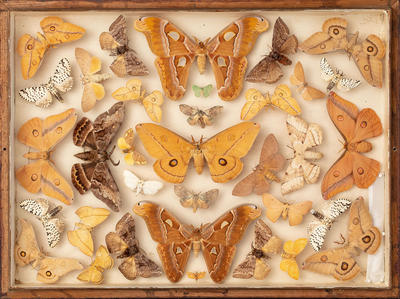Frederick Parkhurst Dodd
Details
Biography
Frederick Dodd was born in 1861 in Wickliffe, a small country town in southwest Victoria. He was the eldest of eight children. He started working at Union bank in Stawell, Victoria in 1879. In 1884, he was transferred to the bank in Townsville. It was during his time in Townsville that he was introduced to butterfly collecting and received a medal for his butterfly collection at the Townsville show in 1887. He also married Jane Dempsey in Townsville in 1887.
The bank transferred him to Brisbane in 1888. Here, he became involved with the Natural History Society and became friends with several noted entomologists of the time. Most influential of these was Roland Illidge, a teacher and noted naturalist.
In 1894, Dodd and his family were transferred to Charters Towers. While in Charters Towers, his youngest son died from lead poisoning, and it was during this time that Dodd decided to quit the bank and try to earn a living from insects.
In April 1895, he and his family returned to Brisbane. He began to collect and supply insects to museums and several wealthy collectors overseas, including Lord Walter Rothschild, Charles Oberthür and Lord Thomas Walshingham. It should be noted that most of the specimens Dodd sold to overseas collectors ended up in the British Museum of Natural History (now “The Natural History Museum”, London), and this collection represents the largest holding of Australian insects overseas. Many new species and genera were named from these specimens, before and after they were transferred to the Natural History Museum. At least 92 species were named after him, many featuring the species name “doddi”.
Hoping to find more tropical insects for research and study, Dodd and his family moved to Townsville in 1899. He published several natural history observations in scientific journals during this time, including life histories of the rare Moth butterfly and the Cyclotorna moth, and parental care in Harlequin bugs.
In 1903, a devastating cyclone struck Townsville, destroying Dodd’s house, his collections and journals. At this point, he decided to move the family to Kuranda in the heart of the rich and unexplored rainforests of the Cairns region. He continued to collect and publish, most notably on the giant Hercules Moth and Wood Moths. He made lengthy expeditions to Darwin and New Guinea to fill his clients' requests.
As Kuranda became a popular tourist destination, Dodd developed a show collection of spectacular insects in his home and charged admission. He wanted to share the natural history treasures of north Queensland with the Australian public so decided to make a travelling show collection. He personally toured this collection in 1918 to Townsville, Brisbane, Sydney, Melbourne, Adelaide and12 Victorian country centres. He toured the collection to southern states again in 1923. He became nationally known as "The Butterfly man of Kuranda”.
Frederick died in Kuranda in 1937. He is buried in the Kuranda cemetery with his gravestone stating:
Frederick Parkhurst Dodd
1861-1937
“The Butterfly Man of Kuranda”
And whenever the way seemed long
and his heart began to fail
SHE would sing a more wonderful song
or tell a more marvelous tale.
Longfellow
The bank transferred him to Brisbane in 1888. Here, he became involved with the Natural History Society and became friends with several noted entomologists of the time. Most influential of these was Roland Illidge, a teacher and noted naturalist.
In 1894, Dodd and his family were transferred to Charters Towers. While in Charters Towers, his youngest son died from lead poisoning, and it was during this time that Dodd decided to quit the bank and try to earn a living from insects.
In April 1895, he and his family returned to Brisbane. He began to collect and supply insects to museums and several wealthy collectors overseas, including Lord Walter Rothschild, Charles Oberthür and Lord Thomas Walshingham. It should be noted that most of the specimens Dodd sold to overseas collectors ended up in the British Museum of Natural History (now “The Natural History Museum”, London), and this collection represents the largest holding of Australian insects overseas. Many new species and genera were named from these specimens, before and after they were transferred to the Natural History Museum. At least 92 species were named after him, many featuring the species name “doddi”.
Hoping to find more tropical insects for research and study, Dodd and his family moved to Townsville in 1899. He published several natural history observations in scientific journals during this time, including life histories of the rare Moth butterfly and the Cyclotorna moth, and parental care in Harlequin bugs.
In 1903, a devastating cyclone struck Townsville, destroying Dodd’s house, his collections and journals. At this point, he decided to move the family to Kuranda in the heart of the rich and unexplored rainforests of the Cairns region. He continued to collect and publish, most notably on the giant Hercules Moth and Wood Moths. He made lengthy expeditions to Darwin and New Guinea to fill his clients' requests.
As Kuranda became a popular tourist destination, Dodd developed a show collection of spectacular insects in his home and charged admission. He wanted to share the natural history treasures of north Queensland with the Australian public so decided to make a travelling show collection. He personally toured this collection in 1918 to Townsville, Brisbane, Sydney, Melbourne, Adelaide and12 Victorian country centres. He toured the collection to southern states again in 1923. He became nationally known as "The Butterfly man of Kuranda”.
Frederick died in Kuranda in 1937. He is buried in the Kuranda cemetery with his gravestone stating:
Frederick Parkhurst Dodd
1861-1937
“The Butterfly Man of Kuranda”
And whenever the way seemed long
and his heart began to fail
SHE would sing a more wonderful song
or tell a more marvelous tale.
Longfellow
Born/Established
b.1861
Died/Ceased
d.1937
Place of Birth
Wickliffe, Victoria, Australia
Place of Death
Kuranda, North East, Queensland, Australia






















